What to do if my Sharp LCD TV has no power?
- WwatsonjennaAug 17, 2025
First, ensure that you have pressed the POWER button on the remote control. Next, check if the AC cord is properly connected. Finally, verify that the power has been turned on.
What to do if my Sharp LCD TV has no power?
First, ensure that you have pressed the POWER button on the remote control. Next, check if the AC cord is properly connected. Finally, verify that the power has been turned on.
Why does my Sharp AQUOS LC-40LE830U LCD TV suddenly turn off?
Your Sharp LCD TV might be turning off suddenly because the sleep timer is set, so check that first. Also, review the power control settings. If the unit's internal temperature has increased, remove any objects blocking the vents or clean them.
What to do if my Sharp AQUOS LC-40LE830U remote control doesn't operate?
First, ensure that the equipment to be operated is set correctly by pressing TV to set the remote control unit to the setting for operating the TV. Also, check if the batteries are inserted with the correct polarity. Replace the batteries if they are worn out. Ensure you are not using the remote under strong or fluorescent lighting, and that a fluorescent light is not illuminated near the remote control sensor. Finally, check if 'RC Control Lock' is selected in 'Operation Lock Out'.
What to do if my Sharp AQUOS LC-40LE830U has no picture?
First, check if the connection to other components is correct. Next, ensure that the correct input is selected. Verify that 'On' is not selected in 'Audio Only'. If the PC image is not displayed, check that the display output mode of the PC is set to external monitor. Finally, check the resolution setting on the PC to ensure a compatible signal is being input.
What to do if my Sharp LCD TV unit cannot be operated?
If your Sharp LCD TV cannot be operated, and it might be due to external influences like lightning or static electricity, turn off the power of the TV or unplug the AC cord. After waiting for 1 or 2 minutes, replug it in and try operating the unit again.
What to do if the original home page cannot be displayed on my Sharp AQUOS LC-40LE830U?
Ensure the ETHERNET cable is connected correctly. Check the settings of 'Internet Setup'.
Why are some Internet functions unavailable on my Sharp AQUOS LC-40LE830U LCD TV compared to a PC?
The TV has only limited functions compared with regular PC browsers.
Why is the picture quality of HD programs poor on my Sharp AQUOS LC-40LE830U?
To enjoy HD images from external equipment, ensure you have set up an HDMI or component connection. If the program content is not of HD quality, HD images cannot be displayed. The cable/satellite set-top box may need to be configured to output HD images via cable/satellite. Also, the cable/satellite broadcast may not support a signal resolution of 1080p.
Why is the picture cut off or has a sidebar screen on my Sharp LCD TV?
Check if the image position is correct. Also, verify that screen mode adjustments such as picture size are made correctly.
Why does my Sharp AQUOS LC-40LE830U LCD TV have strange color, light color, or color misalignment?
Adjust the picture tone. Also, consider if the room is too bright, as this can make the picture look dark.
Critical warnings about electrical shock, moisture, and equipment handling.
Details regarding FCC regulations, declarations, and radiation exposure statements.
Core safety instructions including reading manuals, handling electricity, and cleaning.
Safety measures related to environment, installation, heat, and power lines.
Precautions for transporting the TV, caring for its parts, and child safety.
Instructions for securely attaching the TV stand to the unit.
Steps for initial setup and connecting the TV for basic operation.
Guide on operating the TV using the provided remote control unit.
Guidance on connecting antenna cables for optimal TV reception.
Instructions for inserting batteries into the remote control unit.
Identification of all external connectors and ports on the TV.
Detailed layout and function of each button on the remote control.
Information on how to get the best HD picture from various sources.
Overview of different input terminals and their compatibility for quality.
Steps to select and display content from connected external devices.
Guide for connecting devices using HDMI and DVI-HDMI cables.
Connecting devices via Component and Composite video/audio cables.
Connecting audio amplifiers using optical or audio cables.
Steps for connecting a computer to the TV via HDMI, DVI, or RGB.
Procedures for powering the TV and performing the first-time setup.
Configuring language, TV location, and TV reception type.
Performing automatic channel scans and managing channel settings.
Methods for changing channels and adjusting audio volume directly.
Explanations of Mute, Sleep Timer, Flashback, and Freeze functions.
Using buttons for AV Mode, Input, Apps, and Power Saving settings.
How to enable and manage closed captioning services for TV programs.
Adjusting the screen aspect ratio and size for different content.
How to access and navigate the TV's on-screen menu system.
Adjusting various picture parameters like brightness, contrast, and color.
Customizing audio preferences such as volume, surround, and voice clarity.
Settings for managing power consumption and automatic shut-off features.
Configuration of system-level features like view options and input settings.
Options for reconfiguring initial TV settings like language and channel setup.
Setting up content ratings and parental control features for child safety.
Viewing TV information and updating system software.
How to connect USB devices and DLNA servers for media playback.
Navigating and playing photos, music, and videos from USB or DLNA.
Managing slide show settings, BGM, and removing USB devices.
Configuring DivX registration and checking media file format compatibility.
Programming the remote to control other connected AV devices.
Using the remote to control external devices like STB, DVD, VCR.
Interactively operating HDMI-CEC compatible devices using the TV remote.
Configuring AQUOS LINK features like auto power and recorder selection.
Managing media types for recorders and selecting HDMI devices.
Connecting a PC and optimizing the display image and audio input.
Using IP or RS-232C for PC control of TV functions and communication settings.
Steps for establishing an Ethernet or wireless internet connection and network settings.
Using the toolbar, tabs, bookmarks, and customizing browser behavior.
Accessing online apps, managing software, and legal disclaimers for internet services.
Instructions for safely detaching the TV stand from the unit.
Guidelines for wall-mounting the TV and listing available optional accessories.
Solutions for common problems like no power, picture issues, or no sound.
Procedures for resetting secret numbers and listing product trademarks.
Detailed technical specifications for the TV models, including dimensions and inputs.
Technical details regarding the TV's wireless LAN capabilities and certifications.
Details about the software components and their licensing agreements.
Terms and conditions of the limited warranty for the product, including exclusions.
Procedures for getting service, contact information, and warranty coverage details.
Physical dimensions of the TV models and compatible wall mount brackets.
Critical warnings about electrical shock, moisture, and equipment handling.
Details regarding FCC regulations, declarations, and radiation exposure statements.
Core safety instructions including reading manuals, handling electricity, and cleaning.
Safety measures related to environment, installation, heat, and power lines.
Precautions for transporting the TV, caring for its parts, and child safety.
Instructions for securely attaching the TV stand to the unit.
Steps for initial setup and connecting the TV for basic operation.
Guide on operating the TV using the provided remote control unit.
Guidance on connecting antenna cables for optimal TV reception.
Instructions for inserting batteries into the remote control unit.
Identification of all external connectors and ports on the TV.
Detailed layout and function of each button on the remote control.
Information on how to get the best HD picture from various sources.
Overview of different input terminals and their compatibility for quality.
Steps to select and display content from connected external devices.
Guide for connecting devices using HDMI and DVI-HDMI cables.
Connecting devices via Component and Composite video/audio cables.
Connecting audio amplifiers using optical or audio cables.
Steps for connecting a computer to the TV via HDMI, DVI, or RGB.
Procedures for powering the TV and performing the first-time setup.
Configuring language, TV location, and TV reception type.
Performing automatic channel scans and managing channel settings.
Methods for changing channels and adjusting audio volume directly.
Explanations of Mute, Sleep Timer, Flashback, and Freeze functions.
Using buttons for AV Mode, Input, Apps, and Power Saving settings.
How to enable and manage closed captioning services for TV programs.
Adjusting the screen aspect ratio and size for different content.
How to access and navigate the TV's on-screen menu system.
Adjusting various picture parameters like brightness, contrast, and color.
Customizing audio preferences such as volume, surround, and voice clarity.
Settings for managing power consumption and automatic shut-off features.
Configuration of system-level features like view options and input settings.
Options for reconfiguring initial TV settings like language and channel setup.
Setting up content ratings and parental control features for child safety.
Viewing TV information and updating system software.
How to connect USB devices and DLNA servers for media playback.
Navigating and playing photos, music, and videos from USB or DLNA.
Managing slide show settings, BGM, and removing USB devices.
Configuring DivX registration and checking media file format compatibility.
Programming the remote to control other connected AV devices.
Using the remote to control external devices like STB, DVD, VCR.
Interactively operating HDMI-CEC compatible devices using the TV remote.
Configuring AQUOS LINK features like auto power and recorder selection.
Managing media types for recorders and selecting HDMI devices.
Connecting a PC and optimizing the display image and audio input.
Using IP or RS-232C for PC control of TV functions and communication settings.
Steps for establishing an Ethernet or wireless internet connection and network settings.
Using the toolbar, tabs, bookmarks, and customizing browser behavior.
Accessing online apps, managing software, and legal disclaimers for internet services.
Instructions for safely detaching the TV stand from the unit.
Guidelines for wall-mounting the TV and listing available optional accessories.
Solutions for common problems like no power, picture issues, or no sound.
Procedures for resetting secret numbers and listing product trademarks.
Detailed technical specifications for the TV models, including dimensions and inputs.
Technical details regarding the TV's wireless LAN capabilities and certifications.
Details about the software components and their licensing agreements.
Terms and conditions of the limited warranty for the product, including exclusions.
Procedures for getting service, contact information, and warranty coverage details.
Physical dimensions of the TV models and compatible wall mount brackets.
| Screen Size | 40 inches |
|---|---|
| Display Type | LCD |
| Backlight Type | LED |
| Refresh Rate | 120 Hz |
| HDMI Ports | 4 |
| USB Ports | 1 |
| Audio Output | 10W x 2 |
| Smart TV | Yes |
| Ethernet Port | Yes |
| Wi-Fi | Yes |
| Resolution | 1920 x 1080 |
| 3D | Yes |
| Built-in Tuner | ATSC/QAM |
| Viewing Angle | 176 degrees |
| Connectivity | HDMI, USB, Ethernet, Component, Composite |
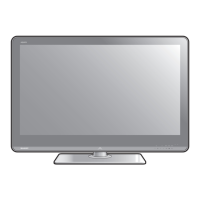
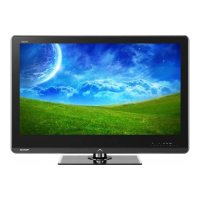

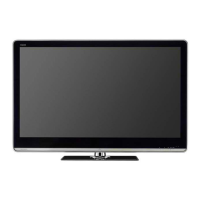
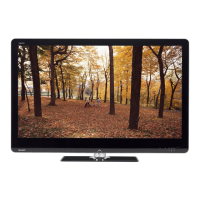
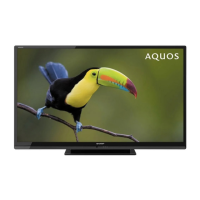

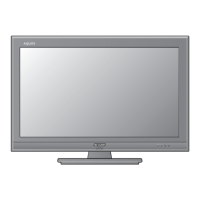
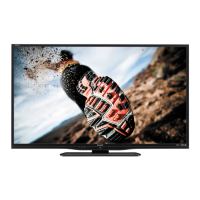

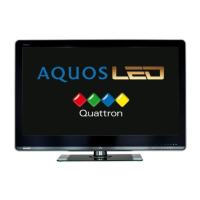
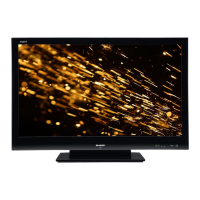
